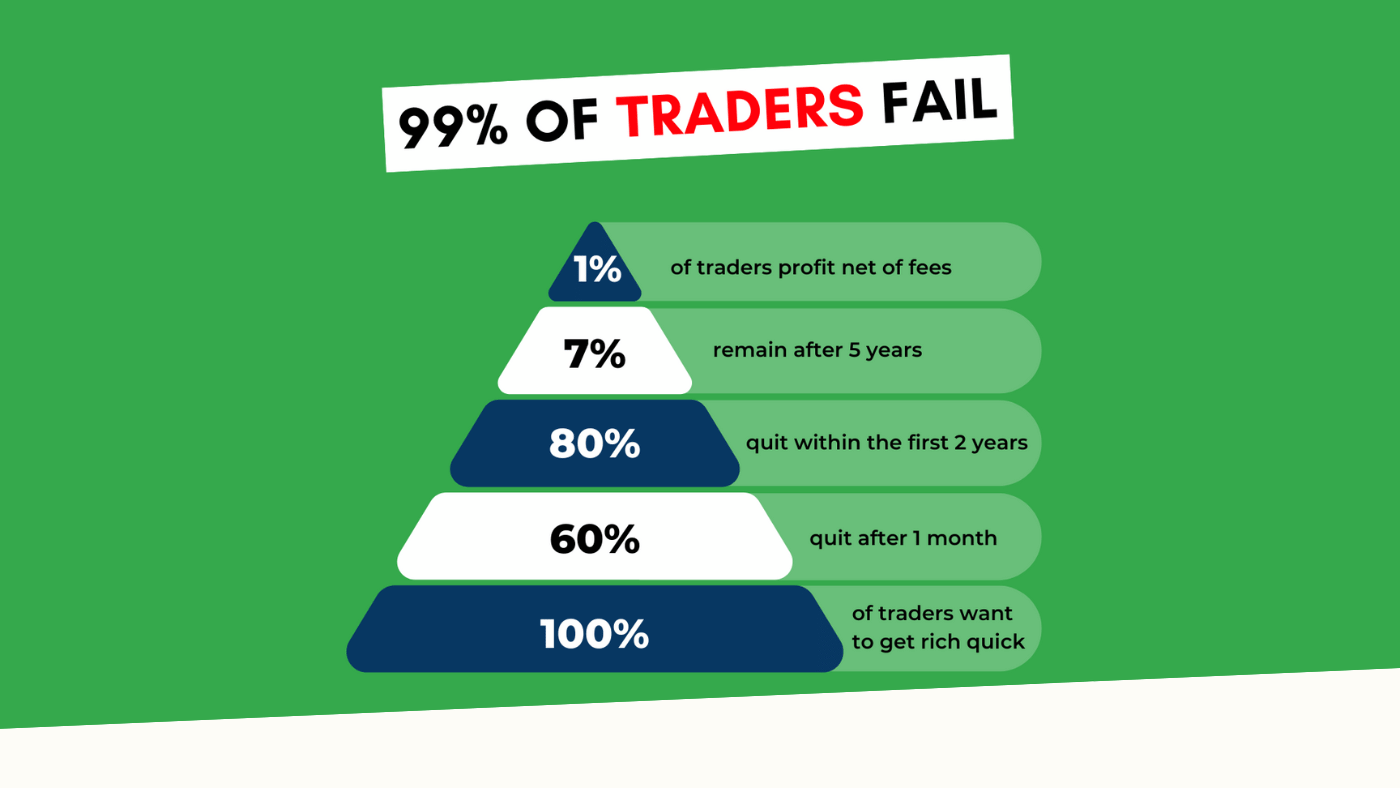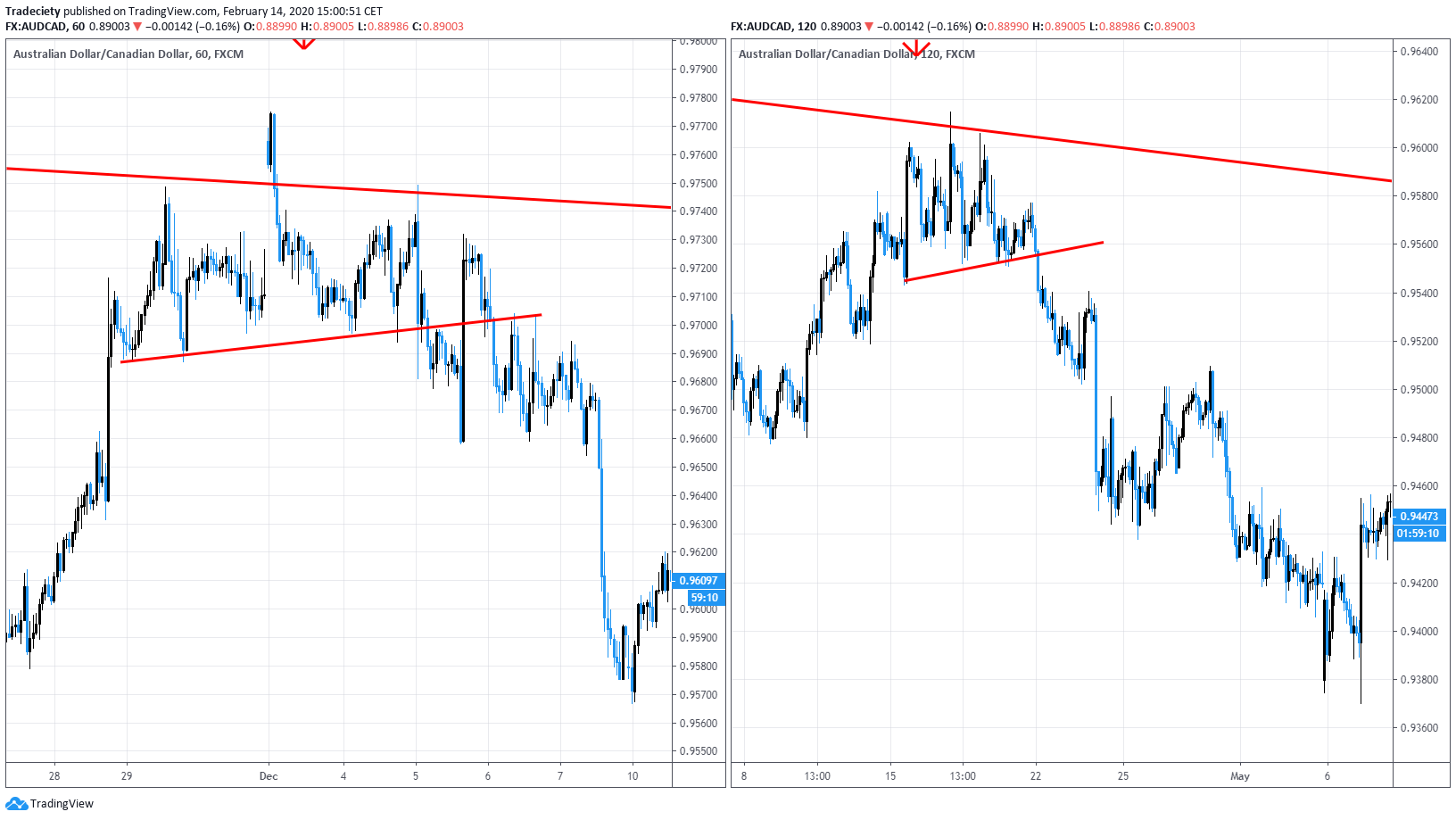3 min read
Scientist Discovered Why Most Traders Lose Money – 24 Surprising Statistics
“95% of all traders fail” is the most commonly used trading related statistic around the internet. But no research paper exists that proves this...
What does it take to become a successful trader? Having mentored traders for the last 8 years, we have seen a lot of traders come and go. But we have also seen similarities among the traders that have shown great progress. This is why we have compiled the eight steps that traders have to go through in order to improve their trading and, hopefully, start making money.
The first thing on your agenda is choosing the market(s) that you want to trade. Do you want to trade currencies (Forex), stocks, or Futures? Each market has its pros and cons, and no market is better than the other.
The choice comes down to personal preferences, but traders also must factor in how trading a specific market fits into their overall lifestyle. If you have a demanding day job without the ability to check in on your charts and trades during the day, day trading your domestic stock market might not be an option because the stock market typically opens from 9 a.m. until 5 p.m. The Forex and Futures markets are open throughout the week (with some exceptions) and might provide more flexibility.
A trader could, for example, trade international currencies or commodity Futures during the evening after work. Alternatively, traders can opt for a long-term trading approach (swing trading) where they don’t have to keep up with charts during the day, and checking your trades once a day might be sufficient.
Getting this first step right is crucial because it determines how effectively you will be able to monitor and manage your markets and your trades.
Now, you need a trading strategy. A quick Google search yields thousands of results for trading strategies but how do you find the right one and what do you have to look out for when choosing your trading strategy?
In your first 9 - 18 months, you have to explore different strategy types to get an understanding of the different approaches to timing, managing, and exiting trades. What I would suggest is that you try a new trading strategy every 3 to 4 months. This will give you enough time to get a good understanding of each trading strategy. After you have gone through 3 to 6 different trading strategies, you should have a good idea of what feels best to you. During this step it is not so much about finding a trading strategy that will make you the most amount of money, but about understanding what type of trader you are and which analytical and trading approach suits you and your way of thinking.
When it comes to trading strategies, make sure that you have a “complete” trading strategy. This means, that the trading strategy should contain rules for all the following:
Many new traders make the mistake of focusing exclusively on the trade timing and entry-picking aspect of a trading strategy and neglect the rest. The result is that once they are in a trade, they have no rules for managing their trades and how to respond to price movements. Inevitably, traders will then lose money and they attribute their failure to wrong entry rules because they don’t know that there are other, vital aspects of a trading strategy.
If you do not know where to start, take a look at our Tradecademy where I provide ready-to-use, complete trading strategies that are ideal for finding out what suits you.
There comes a time when you have to settle for a trading strategy and stop experimenting. It is important to realize that you do not just find a trading strategy that will make you money from the beginning. Rather, it is a process to make a trading strategy work and adapt it to the instruments that you are trading. Furthermore, you have to become the trader that can execute their trading strategy effectively without getting emotional and deviating from your plans.
In the beginning, you will notice that even though you might have a complete trading strategy with solid rules, you will not be able to execute your trades as optimally as you should. This is completely normal! Becoming a trader is a process.
At this stage, you will be tempted to abandon your trading strategy after realizing your first few losing trades. You must resist this urge because, in 99% of all cases, it is not the trading strategy that needs to change, but it is you that has to change. This might sound strange, but the next point will go deeper into this.
We have worked with thousands of traders over the years and we have seen time and again that many traders struggle to accept that even a winning trading system can (and will) experience losses regularly. When traders cannot accept that a system can lose, even though it might make money long-term, they are more likely to jump to a new strategy, hoping to find one that will not encounter losses. The sooner the trader is ready to accept that a “perfect” trading system doesn’t exist, the better for their overall progress.
Reviewing your trades regularly serves two major purposes.
First, most traders will realize that the losses they experience are caused by themselves. This means most losses will be the result of deviating from your trading rules. Of course, sometimes you will do everything correctly and the trade will still not work out. In the beginning, however, it is more likely that a large part of your trading losses is caused by you breaking your trading rules. This is good news because it means that the trader doesn’t have to change to a new trading strategy, but instead, they must start working on themselves, creating better-coping mechanisms, and improving their discipline. Go through each of your last trades and check if you did something wrong and how you could have improved your decision-making.
Furthermore, a regular trade review can also reveal problems with your trading strategy. Recently, I talked to a trader that I mentor, and he said that although most of his trades would have worked out, 90% of the time, the price hit the stop loss first before returning into the anticipated trade direction. In such cases, the trader probably uses a stop loss that is too close to the price and by giving his trades a bit more room to unfold, he may be able to turn some of the losses into wins. Such insights are invaluable and can only be spotted during a trade review.
Unfortunately, most traders don’t regularly review their trades and therefore never learn from their mistakes. Nowadays, there are many great solutions for traders and we also created the Edgewonk.com trading journal that makes the review process easy and efficient.
Backtesting is, besides keeping a trading journal, another great way for traders to speed up their learning progress. During a backtest, the trader goes through historical price data and looks for trading opportunities by applying their trading rules. The goal is to evaluate how the trading strategy and the specific trading rules would have performed in the past. Traders can gain important insights through backtesting such as the historical winrate, how many trading signals the strategy generates on average, and what the best reward:risk ratio would have been.
But a backtest will also allow traders to improve their pattern recognition. Most traders will use technical analysis, price action and/or patterns in their trading, and in the beginning, your pattern recognition skills won´t be great. But by going through a lot of historical data and placing dozens of backtest trades, you will be exposed to a wide variety of different chart scenarios. This will then allow traders to become more efficient in spotting good trading opportunities in their real-time trading later.
More backtesting is always better and I would recommend spending as much time backtesting as you can. Whenever you have some downtime, schedule a 30-minute backtesting session to squeeze in some quality learning time.
Going live refers to starting trading real money. In the first few months, traders typically trade a so-called demo trading account where they trade fictional money with real-time market data. The question of when the optimal time is to make the transition to trading real money inevitably always comes up.
Unfortunately, there is no objectively right answer when it comes to determining the optimal time to start trading real money. Before you start trading real money you should have a good understanding of your trading strategy and you should have backtested historical data to verify that your trading rules would have made money in the past. However, this is no guarantee that the same rules will also make money going forward.
Nowadays, with the emergence of funding companies that will provide real capital to traders, this might also be a valid option. The benefit of a funding challenge is that the trader does not trade their own money while being exposed to rigid risk management rules, set by the funding companies. Learning to trade within the risk limitations might be a great training process for new traders because it forces them to apply conservative risk management measurements. This will also bring us to the next point on this list.
Most traders, when they start trading, believe that trading is a way to make a lot of money in no time. Although reality will usually catch up very quickly and it is becoming clear that making (a lot of) money is not going to be that easy, many traders can´t let go of their dream and they keep pushing their luck. And to make a lot of money, traders have to take on a lot of risk. High levels of risk usually lead to margin calls and traders losing a lot of money.
Therefore, in your beginnings, you should practice risk management and especially position sizing. Typically, trading books and other high-profile traders recommend the 1% position size rule. This means that you do not risk more than 1% of your trading capital per trade. This is a great starting point because it reduces the likelihood of large losses which then lead to emotional trading and traders losing even more.
One issue many traders face is that their trading accounts are so small that risking 1% per trade and then maybe making 3% or 4% per trade is meaningless and traders cannot take their trading seriously enough. The great thing about starting a funding challenge is that the funding companies usually have very tight risk management rules which force traders to stick to their position sizing principles. Instead of self-funding a $300 or $500 trading account, paying $100 for the smallest funding challenge might be a great alternative for many traders. The level of accountability that the funding challenges provide can help traders trade with more consistency and take less risk.
Trading is a game of patience. Traders need patience when waiting for their trading opportunities, it requires patience to stay in a good trade to maximize profits, and traders need to be patient when it comes to growing a trading account.
Once you have settled on a trading strategy, have backtested your trading rules to verify that historically they could have made money, started journaling your trades to learn from your mistakes, and practiced safe risk management, the grind starts.
Trading is a long-term game and the saying ´Rome wasn’t built in a day´ is 100% applicable to trading. In the beginning, when you are not a full-time trader and still have a regular day job, you have a few great advantages. First, there is no (or very minimal) pressure to generate an income from your trading. Your day job will pay for your bills, and you can trade with a free mind. Also, you can start growing your trading account by regularly depositing into your brokerage account. BUT only do this once you have proven, over a stretch of multiple months, that you can actually make money long-term in a sustainable way.
You have to acknowledge that accumulating capital is a long-term play and that, with a reasonable position sizing strategy, it will take time to grow your trading account. Many traders break at this point because they want too much, too fast. There is no rush, though, and you cannot force to market to oblige to your own artificially created growth goals. And even if it may take 5 or more years, the end result will still be worth it because shortcuts don’t lead anywhere.

3 min read
“95% of all traders fail” is the most commonly used trading related statistic around the internet. But no research paper exists that proves this...

3 min read
Trendlines can be great trading tools if used correctly and in this post, I am going to share three powerful trendline strategies with you.

3 min read
Choosing the right trading journal is essential for traders wanting to analyze performance, refine strategies, and improve consistency. In this...
